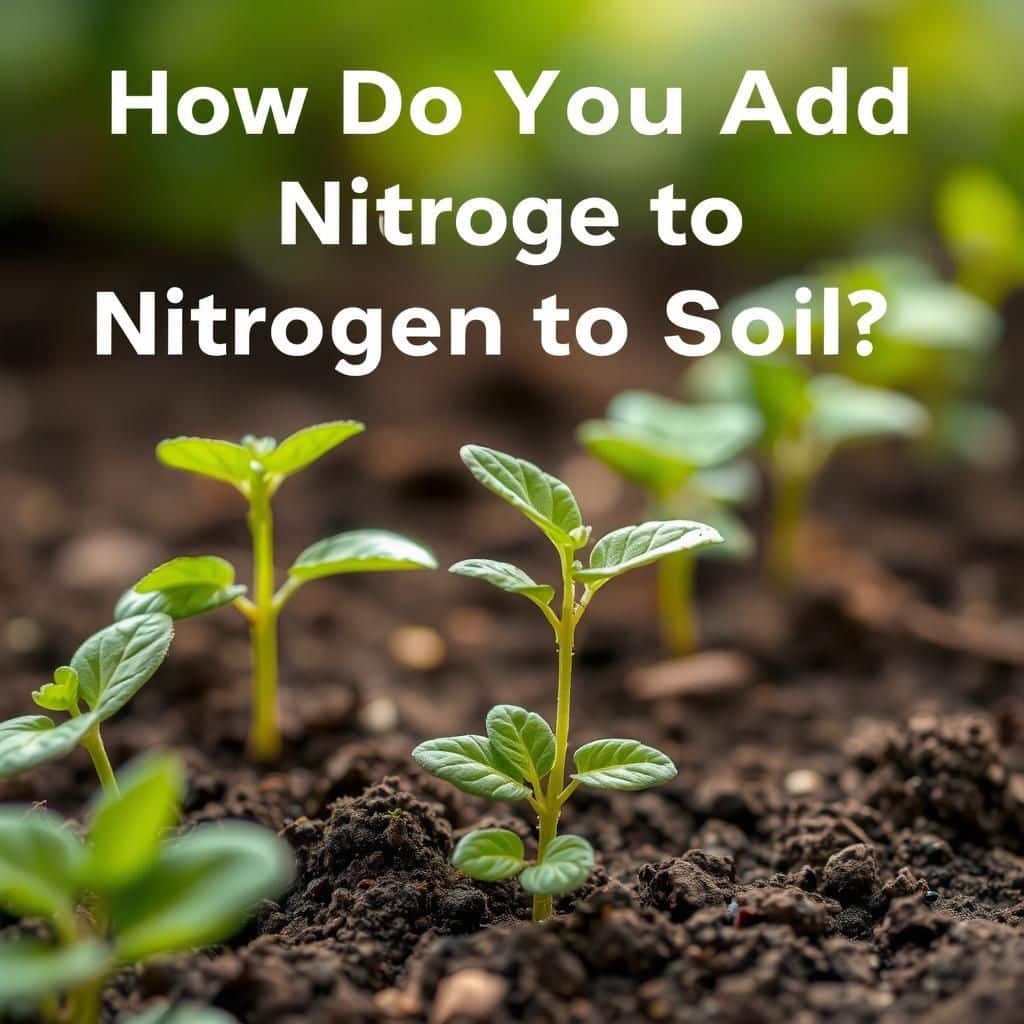How Do You Add Nitrogen to Soil: Effective Methods for Healthy Plant Growth

Nitrogen is a crucial nutrient that plays a vital role in plant growth and development. As a primary component of amino acids, proteins, and chlorophyll, adequate nitrogen levels are essential for healthy vegetation. However, many gardeners and farmers struggle with nitrogen-deficient soils, which can lead to stunted growth and poor crop yields. This article explores effective methods for adding nitrogen to soil, ensuring plants receive the nutrition they need. From organic amendments to natural fertilizers, we’ll examine various strategies to enrich your soil, fostering robust growth and vibrant gardens. Discover how to create a thriving environment for your plants.
How to Add Nitrogen to Soil
Adding Nitrogen to soil is crucial for promoting healthy plant growth, as this essential nutrient is a key component of amino acids and proteins. One of the most effective methods to increase nitrogen levels in the soil is through the use of organic matter, such as compost or well-rotted manure, which not only enriches the soil with nitrogen but also improves its overall structure and moisture retention. Additionally, planting cover crops like clover or beans can naturally fix atmospheric nitrogen and increase the nutrient levels in the soil. Monthly soil testing can help monitor nitrogen levels, while the application of nitrogen fertilizers, both synthetic and organic, should be done in a calculated manner to avoid runoff and leaching issues.
Organic Matter as a Nitrogen Source
Organic matter, such as compost and manure, serves as an excellent source of nitrogen for soil enhancement. When adding organic matter, it decomposes over time, releasing nitrogen in a form that plants can readily absorb. It is recommended to incorporate well-aged manure or quality compost into the soil before planting or as a top dressing during the growing season, as this method promotes a healthy microbial environment and sustained nutrient release.
Cover Crops for Nitrogen Fixation
Cover crops are a sustainable method to enrich the soil with nitrogen naturally. Plants such as clover, vetch, and legumes possess the ability to fix atmospheric nitrogen through their symbiotic relationships with rhizobia bacteria. By planting these crops during the off-season, gardeners can enhance soil nitrogen levels significantly, which is released back into the soil when the cover crops are tilled under before the main planting season.
Commercial Nitrogen Fertilizers
Commercial nitrogen fertilizers are another option for increasing nitrogen content in soil, and they come in both synthetic and organic forms. Synthetic options, such as ammonium nitrate, provide a quick release of nitrogen, while organic fertilizers, like blood meal or fish emulsion, offer a slower, gradual release. It's crucial to follow application guidelines carefully to avoid nutrient burn or ecological disturbances, ensuring optimal plant growth without harming the environment.
Soil Testing for Nitrogen Levels
Regular soil testing is essential to determine the current nitrogen levels and overall nutrient status of your soil. By conducting a soil test, you can receive specific recommendations on how much nitrogen to add for optimal plant health. Soil tests typically provide information on pH, organic matter, and nutrient levels, allowing you to make informed decisions about amendments like fertilizers or organic matter additions.
Combining Nitrogen Sources
Combining different sources of nitrogen can create a balanced approach to soil enrichment. Using a mixture of organic matter, cover crops, and controlled-release nitrogen fertilizers allows for a steady supply of nitrogen that can adapt to the changing needs of plants throughout their growth cycle. This strategy not only increases nitrogen availability but also enhances soil health by supporting diverse microbial activity and improving soil structure.
| Nitrogen Source | Type | Release Rate |
|---|---|---|
| Compost | Organic | Slow |
| Well-rotted manure | Organic | Moderate |
| Cover crops | Organic | Variable |
| Ammonium nitrate | Synthetic | Fast |
| Blood meal | Organic | Fast |
What is a good source of nitrogen for soil?
:max_bytes(150000):strip_icc()/ways-to-add-nitrogen-to-soil-7099813-FINAL-333715a5c6c542c1833944a9dde06871.png)
A good source of nitrogen for soil includes both organic and inorganic materials that can enhance soil fertility. Nitrogen is an essential nutrient for plant growth, as it is a fundamental building block of amino acids, proteins, and chlorophyll. Below are several sources of nitrogen that can be beneficial for soil health.
Organic Sources of Nitrogen
Organic sources of nitrogen are derived from living organisms and are typically more sustainable than synthetic options. They gradually release nitrogen into the soil, improving both soil structure and fertility.
- Compost: Decomposed organic matter rich in nitrogen.
- Manure: Fresh or aged manure from livestock provides a significant nitrogen boost.
- Green Manure: Cover crops like clover and alfalfa can be tilled into the soil to enrich it with nitrogen.
Inorganic Sources of Nitrogen
Inorganic sources of nitrogen usually act quickly and are often used for immediate soil nutrient needs. These sources can enhance plant growth rapidly but can also lead to nutrient leaching.
- Ammonium Nitrate: A widely used fertilizer that contains both ammonium and nitrate forms of nitrogen.
- Urea: A high nitrogen fertilizer that needs to be converted by soil microbes into ammonium before plants can use it.
- Calcium Nitrate: A fertilizer that provides both calcium and nitrogen, beneficial for soil and plants.
Fixation of Atmospheric Nitrogen
Certain plants, particularly legumes, have the ability to fix atmospheric nitrogen through symbiotic relationships with bacteria in their root nodules, enriching the soil naturally.
- Legumes: Crops such as peas, beans, and lentils enhance soil nitrogen levels.
- Nitrogen-Fixing Bacteria: Rhizobia and Frankia are examples of bacteria that assist legumes in nitrogen fixation.
- Crop Rotation: Rotating legumes with other crops can improve overall soil nitrogen content.
Cover Crops for Nitrogen Enhancement
Cover crops are planted to cover and protect the soil instead of for direct harvest. They can be integral in maintaining soil health and bolstering nitrogen levels.
- Clover: A popular cover crop that adds significant nitrogen to the soil.
- Vetch: Often used for its ability to fix nitrogen, it also improves soil structure.
- Rye: Helps prevent soil erosion and contributes to nitrogen levels when turned under.
Importance of Nitrogen in Agriculture
Nitrogen is a critical macronutrient necessary for optimal crop growth and development. Its role in agriculture cannot be understated, as it affects yield and plant health.
See also:
- Growth Promotion: Nitrogen is crucial for the synthesis of proteins and nucleic acids.
- Photosynthesis: It contributes to the formation of chlorophyll, enabling effective photosynthesis.
- Soil Fertility: Sufficient nitrogen levels are essential for maintaining healthy soil ecosystems.
Do coffee grounds add nitrogen to the soil?
:max_bytes(150000):strip_icc()/using-coffee-grounds-in-your-garden-2539864_FINAL-025580b008314747ad1a5d6411baf988.png)
Coffee grounds can indeed contribute to soil nitrogen levels, but the extent and method of their impact require a deeper understanding. Coffee grounds contain about 2% nitrogen by weight, making them a valuable organic material for garden soil. However, to utilize coffee grounds effectively for nitrogen enhancement, gardeners should consider several factors.
Composition of Coffee Grounds
Coffee grounds are primarily composed of organic matter, including proteins, lipids, and carbohydrates. Their composition includes:
- Nitrogen: Approximately 2% of the dry weight.
- Phosphorus: Present in smaller amounts, beneficial for root development.
- Potassium: Also beneficial, playing a role in overall plant health.
While coffee grounds do have some nitrogen, it's essential to balance them with other nitrogen sources for optimal soil health.
Benefits of Using Coffee Grounds in the Garden
In addition to nitrogen, coffee grounds offer several benefits:
- Soil Structure Improvement: They enhance soil aeration and drainage.
- Microbial Activity: They promote beneficial microbes that decompose organic matter.
- pH Level Adjustment: Coffee grounds are slightly acidic, which can help balance alkaline soils.
These benefits make coffee grounds a useful addition to compost or directly to the soil.
How to Use Coffee Grounds in Gardening
Utilizing coffee grounds effectively requires proper application methods:
- Mix with Compost: Combine grounds with other materials to create balanced compost.
- Direct Application: Spread grounds on the soil surface or mix into the topsoil.
- Compost Teas: Brew grounds in water to create nutrient-rich liquid fertilizer.
The method of application can influence how well nitrogen is released into the soil.
Potential Drawbacks of Coffee Grounds
Despite their benefits, there are potential drawbacks to using coffee grounds:
- Excessive Use: Overapplication can lead to soil compaction and reduced water retention.
- Allelopathic Effects: Grounds can inhibit seed germination in some plant species.
- Unbalanced Nutrient Ratios: Relying solely on coffee grounds may not meet all plant nutrient needs.
It's crucial to use coffee grounds judiciously to avoid negative impacts on plant health.
Conclusion on Coffee Grounds and Nitrogen
While coffee grounds do contain nitrogen and can contribute positively to soil health, their use should be considered as part of a broader soil management strategy. By understanding both their benefits and potential drawbacks, gardeners can more effectively enhance their soil with this commonly overlooked material.
How to fix lack of nitrogen in soil?

To fix a lack of nitrogen in soil, it's essential to understand the various methods to replenish this vital nutrient. Nitrogen is crucial for plant growth as it is a fundamental component of amino acids, proteins, and nucleic acids. Here are some effective strategies to enhance nitrogen levels in your soil.
Understanding Nitrogen Deficiency
Nitrogen deficiency can manifest in several ways. Plants may show stunted growth, yellowing of older leaves, and poor fruit or flower development. This deficiency happens when the nitrogen availability in the soil is lower than the needs of the plants. It's essential to regularly test the soil to confirm nitrogen levels and diagnose potential deficiencies.
See also:
Adding Organic Matter
One effective way to improve nitrogen levels in the soil is by incorporating organic matter. This can involve adding compost, well-rotted manure, or green manure crops. These materials not only provide nitrogen but also improve soil structure and water retention.
- Compost: Homemade or store-bought compost can significantly improve soil nitrogen content.
- Manure: Animal waste, when properly aged, is rich in nitrogen and beneficial microorganisms.
- Green Manures: Growing specific crops like clover or vetch during the off-season can fix atmospheric nitrogen when tilled back into the soil.
Using Nitrogen-Fixing Plants
Another strategy is to plant nitrogen-fixing crops. These plants, like legumes (beans, peas, clover), have symbiotic relationships with bacteria in their root nodules, enabling them to capture nitrogen from the atmosphere and convert it into a form usable by plants.
- Legumes: Rotate crops with legumes to naturally enhance soil nitrogen levels.
- Cover Crops: Use cover crops in fallow periods to increase nitrogen fixation.
- Intercropping: Plant legumes between rows of non-leguminous crops for dual benefits.
Applying Synthetic Fertilizers
For quicker results, synthetic fertilizers containing nitrogen can be applied to the soil. Common options include ammonium nitrate, urea, and calcium nitrate. These fertilizers should be used judiciously to avoid over-fertilization, which can harm the environment.
- Ammonium Nitrate: A fast-acting fertilizer that provides a readily available nitrogen source.
- Urea: The most concentrated nitrogen source, ideal for bulk application.
- Calcium Nitrate: Provides both calcium and nitrogen, beneficial for root development.
Soil Testing and Monitoring
Regular soil testing is crucial to address nitrogen deficiency effectively. It allows you to understand nutrient levels, pH, and organic matter content, guiding you in applying the correct amendments.
- Soil Tests: Conduct tests to determine existing nitrogen levels and other nutrients.
- pH Adjustment: Sometimes, nitrogen availability is impacted by soil pH; amend if necessary to optimize conditions.
- Continuous Monitoring: Monitor soil and plant health regularly to adjust practices as needed.
Improving Soil Aeration
Enhanced soil aeration can also help in nitrogen availability. Compacted soil can restrict root growth and limit nutrient uptake. Using practices such as tilling, aerating, or incorporating organic material can improve aeration.
- Tilling: Break up compacted soil to allow better gas exchange and root penetration.
- Mulching: Organic mulch can improve soil structure and promote beneficial microbial activity.
- Incorporation of Gypsum: This mineral can help improve soil structure and aeration, aiding nitrogen processing.
What is the cheapest source of nitrogen?

The cheapest source of nitrogen is generally ammonia (NH₃), particularly when derived from the Haber-Bosch process. This method synthesizes ammonia from atmospheric nitrogen and hydrogen, making it an efficient and cost-effective way to produce nitrogen-rich fertilizers. Other cheaper sources of nitrogen include urea, ammonium sulfate, and even atmospheric nitrogen fixation processes in certain legumes.
Cost Comparison of Nitrogen Sources
The cost of nitrogen can vary significantly depending on the source. Here’s a breakdown of the most commonly used nitrogen sources and their relative costs:
- Ammonia: Often the least expensive due to production efficiency.
- Urea: Slightly more expensive than ammonia but still cost-effective.
- Ammonium Sulfate: Typically more costly compared to urea and ammonia.
Natural versus Synthetic Nitrogen Sources
There are significant differences between natural and synthetic nitrogen sources regarding cost and availability:
- Natural Sources: Plant-based sources like legumes can provide nitrogen naturally but may not be as concentrated or cost-effective for large-scale production.
- Synthetic Sources: Methods like the Haber-Bosch process yield high concentrations of nitrogen, making them more practical for agriculture.
Impact of Nitrogen Prices on Agriculture
The prices of nitrogen fertilizers have a direct impact on agricultural practices and decision-making:
- Crop Yield: Lower nitrogen costs can enhance crop yield through improved fertilization strategies.
- Farming Techniques: Farmers may adjust their cultivation techniques based on nitrogen price fluctuations.
Environmental Considerations
When considering nitrogen sources, environmental factors come into play:
- Runoff: Synthetic nitrogen sources can lead to waterway pollution through runoff.
- Soil Health: Natural nitrogen sources can improve soil health over time through organic matter addition.
Future Trends in Nitrogen Supply
The nitrogen supply landscape is evolving with advancements in technology and agricultural practices:
- Innovation: New methods for nitrogen fixation are being researched, which could lower costs.
- Sustainability: Increasing focus on sustainable practices may drive demand for organic nitrogen sources.
Questions from Our Readers
How can I add nitrogen to my garden soil?
To add nitrogen to your garden soil, you can use organic fertilizers like compost, aged manure, or blood meal, which are rich in nitrogen. When incorporating these materials into your soil, ensure they are well-mixed to promote even distribution and enhance the nutrient availability for your plants.
What types of plants can help increase nitrogen levels in soil?
Plants known as nitrogen-fixers, such as legumes (e.g., peas, beans, and clover), can significantly increase nitrogen levels in your soil. They have a symbiotic relationship with bacteria that convert atmospheric nitrogen into a form that plants can utilize, enriching the soil during their growth cycle.
See also:
Can I use chemical fertilizers to add nitrogen to the soil?
Yes, you can use chemical fertilizers that contain nitrogen, such as ammonium nitrate or urea, to quickly boost nitrogen levels in your soil. However, it's important to follow the recommended application rates to avoid over-fertilization, which can lead to adverse effects on plants and the environment.
How often should I add nitrogen to my soil?
The frequency of nitrogen application depends on several factors, including the type of crops you are growing and soil quality. Generally, it is recommended to add nitrogen during the growing season, especially at the start of a planting cycle, to ensure your plants receive sufficient nutrients for optimal growth. Regular soil tests can help determine your soil's nitrogen needs.

If you want to read more articles like How Do You Add Nitrogen to Soil: Effective Methods for Healthy Plant Growth, we recommend you check out our Soil category.
Leave a Reply
Related Articles